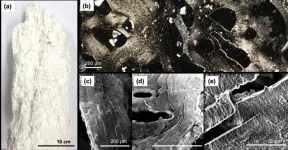(Press-News.org) Large expansion of carbon capture and storage is necessary to fulfill the Paris Climate Agreement. Yet a new study led by Chalmers University of Technology, in Sweden and University of Bergen, in Norway, shows that without major efforts, the technology will not expand fast enough to meet the 2°C target and even with major efforts it is unlikely to expand fast enough for the 1.5°C target.
The idea behind carbon capture and storage (CCS) technology is to capture carbon dioxide then store it deep underground. Some applications of CCS, such as bioenergy with CCS (BECCS) and direct air capture and storage (DACCS) actually lead to negative emissions, essentially “reversing” emissions from burning fossil fuels. CCS technologies play an important role in many climate mitigation strategies including net-zero targets. However, the current use is negligible.
“CCS is an important technology for achieving negative emissions and also essential for reducing carbon emissions from some of the most carbon-intensive industries. Yet our results show that major efforts are needed to bridge the gap between the demonstration projects in place today and the massive deployment we need to mitigate climate change,” says Jessica Jewell, Associate Professor at Chalmers University of Technology in Sweden
A new study titled, ‘Feasible deployment of carbon capture and storage and the requirements of climate targets’, conducted a thorough analysis of past and future growth of CCS to forecast whether it can expand fast enough for the Paris Climate Agreement. The study found that over the 21st century, no more than 600 Gigatons (Gt) of carbon dioxide can be sequestered with CCS.
“Our analysis shows that we are unlikely to capture and store more than 600 Gt over the 21st century. This contrasts with many climate mitigation pathways from the Intergovernmental Panel on Climate Change (IPCC) which in some cases require upwards of 1000 Gt of CO2 captured and stored by the end of the century. While this looks at the overall amount, it’s also important to understand when the technology can start operating at a large scale because the later we start using CCS the lower the chances are of keeping temperature rise at 1.5°C or 2°C. This is why most of our research focused on how fast CCS can expand,” says Tsimafei Kazlou, PhD candidate at University of Bergen, Norway, and first author of the study.
Decrease in CCS failure rate required
The study highlights the need to expand the number of CCS projects that realise this technology and cut failure rates to ensure the technology “takes-off” in this decade. Today, the development of CCS is driven by policies like the EU Net-Zero Industry Act and the Inflation Reduction Act in the US. In fact, if all of today’s plans are realised, by 2030, CCS capacity would be eight times what it is today.
“Even though there are ambitious plans for CCS, there are big doubts about whether these are feasible. About 15 years ago, during another wave of interest in CCS, planned projects failed at a rate of almost 90 percent. If historic failure rates continue, capacity in 2030 will be at most twice what it is today which would be insufficient for climate targets,” says Tsimafei Kazlou.
A promising technology with barriers to overcome
Like most technologies, CCS grows non-linearly and there are examples of other technologies to learn from. Even if CCS “takes-off” by 2030, the challenges won’t stop. In the following decade it would need to grow as fast as wind power did in the early 2000’s to keep up with carbon dioxide reductions required for limiting the global temperature rise to 2°C by 2100. Then starting in the 2040s, CCS needs to match the peak growth that nuclear energy experienced in the 1970s and 1980s.
“The good news is that if CCS can grow as fast as other low-carbon technologies have, the 2°C target would be within reach (on tiptoes). The bad news, 1.5°C would likely still be out of reach,” says Jessica Jewell.
The authors say their analysis underlines the need for strong policy support for CCS combined with a rapid expansion of other decarbonisation technologies for climate targets.
“Rapid deployment of CCS needs strong support schemes to make CCS projects financially viable. At the same time, our results show that since we can only count on CCS to deliver 600 Gt of CO2 captured and stored over the 21st century, other low-carbon technologies like solar and wind power need to expand even faster”, says Aleh Cherp, Professor at Central European University in Austria.
Image description: 3D visualisation of CCS at Sleipner, where carbon dioxide has been successfully stored deep below the North Sea outside the coast of Norway since 1996
Image credit: Equinor
More on the research:
The article, ‘Feasible deployment of carbon capture and storage and the requirements of climate targets’, is published in Nature Climate Change.
Climate mitigation pathways used throughout the study are from the IPCC open-source data.
The article is written by Tsimafei Kazlou of University of Bergen in Norway, Jessica Jewell at Chalmers University of Technology in Sweden and Aleh Cherp at Central European University in Austria.
The research was funded by the European Commission’s H2020 ERC Starting Grant MANIFEST and project ENGAGE in addition to the Mistra Electrification project.
More about the Paris Climate Agreement:
The Paris Climate Agreement is a legally binding international treaty on climate change. It was adopted by 196 Parties at the UN Climate Change Conference (COP21) in Paris, France, on 12 December 2015 and entered into force on 4 November 2016. Its overarching goal is to hold “the increase in the global average temperature to well below 2°C above pre-industrial levels” and pursue efforts “to limit the temperature increase to 1.5°C above pre-industrial levels.”
For more information, please contact:
Jessica Jewell, Associate Professor, Department of Space, Earth and Environment, Chalmers University of Technology, Sweden, jewell@chalmers.se +46 31 772 61 06
Tsimafei Kazlou, Doctoral Student, Center for Climate and Energy Transformations, University of Bergen, Norway, Tsimafei.kazlou@uib.no
The contact persons speak English and are available for live and pre-recorded interviews. At Chalmers, we have podcast studios and broadcast filming equipment on site and would be able to assist a request for a television, radio or podcast interview.
END
Major boost in carbon capture and storage essential to reach 2°C climate target
2024-09-25
ELSE PRESS RELEASES FROM THIS DATE:
‘Invisible forest’ of algae thrives as ocean warms
2024-09-25
An “invisible forest” of phytoplankton is thriving in part of our warming ocean, new research shows.
Phytoplankton are tiny drifting organisms that do about half of the planet’s “primary production” (forming living cells by photosynthesis).
The new study, by the University of Exeter, examined phytoplankton at the ocean surface and the “subsurface” – a distinct layer of water beneath – to see how climate variability is affecting them.
Published in the journal Nature Climate Change, the findings show these two communities are reacting differently.
Over the last decade, the total “biomass” (living material) of subsurface ...
How do rare genetic variants affect health? AI provides more accurate predictions
2024-09-25
Whether we are predisposed to particular diseases depends to a large extent on the countless variants in our genome. However, particularly in the case of genetic variants that only rarely occur in the population, the influence on the presentation of certain pathological traits has so far been difficult to determine. Researchers from the German Cancer Research Center (DKFZ), the European Molecular Biology Laboratory (EMBL) and the Technical University of Munich have introduced an algorithm based on deep learning that can predict the effects of rare genetic variants. The method allows persons with high risk of disease to be distinguished more precisely and facilitates the identification ...
Replacing hype about artificial intelligence with accurate measurements of success
2024-09-25
The hype surrounding machine learning, a form of artificial intelligence, can make it seem like it is only a matter of time before such techniques are used to solve all scientific problems. While impressive claims are often made, those claims do not always hold up under scrutiny. Machine learning may be useful for solving some problems but falls short for others.
In a new paper in Nature Machine Intelligence, researchers at the U.S. Department of Energy’s Princeton Plasma Physics Laboratory (PPPL) and Princeton University performed a systematic review of research comparing machine learning to traditional methods for solving ...
Researchers harness AI to repurpose existing drugs for treatment of rare diseases
2024-09-25
There are more than 7,000 rare and undiagnosed diseases globally.
Although each condition occurs in a small number of individuals, collectively these diseases exert a staggering human and economic toll because they affect some 300 million people worldwide.
Yet, with a mere 5 to 7 percent of these conditions having an FDA-approved drug, they remain largely untreated or undertreated.
Developing new medicines represents a daunting challenge, but a new artificial intelligence tool can propel the discovery of new therapies from existing medicines, offering hope for patients with rare and neglected conditions and for the clinicians who treat them.
The AI model, called TxGNN, is the first one ...
Combination treatment improves response to immunotherapy for lung cancer
2024-09-25
Francis Crick Institute press release
Under strict embargo: 10:00hrs BST Wednesday 25 September 2024
Peer reviewed
Experimental study
Animals
Combination treatment improves response to immunotherapy for lung cancer
Researchers at the Francis Crick Institute, in collaboration with Revolution Medicines, have tested a combination of treatments in mice with lung cancer and shown that these allow immunotherapies to target non-responsive tumours.
Their findings show that targeting tumours in ...
Nanostructures in the deep ocean floor hint at life’s origin
2024-09-25
Researchers led by Ryuhei Nakamura at the RIKEN Center for Sustainable Resource Science (CSRS) in Japan and The Earth-Life Science Institute (ELSI) of Tokyo Institute of Technology have discovered inorganic nanostructures surrounding deep-ocean hydrothermal vents that are strikingly similar to molecules that make life as we know it possible. These nanostructures are self-organized and act as selective ion channels, which create energy that can be harnessed in the form of electricity. Published Sep. 25 in Nature Communications, the findings impact not only our understanding of how life began, but can also ...
Humbug damselfish use 'motion dazzle' to evade predators
2024-09-25
When thinking of animal camouflage, we typically imagine creatures remaining still, blending seamlessly into their surroundings. But remaining motionless isn’t always practical, and many animals are highly mobile, constantly moving through their environment to graze their food.
New research suggests that high-contrast patterns on animals’ bodies may serve a dual purpose: offering camouflage when stationary, then creating a ‘motion dazzle’ effect when moving, confusing potential predators into misjudging their location – and helping them avoid being ...
Can a drug-free nasal spray protect against deadly respiratory infections?
2024-09-25
New research published in Advanced Materials reports a novel nasal spray for preventing respiratory infections. The spray works by forming a protective coating on the nasal cavity, which captures airborne respiratory droplets and acts as a physical barrier against viruses and bacteria, while effectively neutralizing them.
In studies conducted on mice, the Pathogen Capture and Neutralizing Spray (PCANS) demonstrated up to 8 hours of nasal retention. In a severe Influenza A model, a single pre-exposure dose of PCANS resulted in a greater than 99.99% reduction ...
Do natural disasters jeopardize women’s reproductive health?
2024-09-25
In research published in Brain and Behavior, investigators found increased rates of menstrual irregularities in women living in areas affected by the 2023 earthquake in Turkey.
In the study, 309 women of reproductive age living in regions declared as disaster areas completed online forms 9 months after the earthquake. Responses revealed an increase of menstrual irregularities from 14.3% before the earthquake to 44.8% after the earthquake. Risk factors for menstrual irregularities included post-traumatic stress symptoms, chronic diseases, and smoking.
The findings reveal that reproductive health ...
Can cosmic radiation in outer space affect astronauts’ long-term cognition?
2024-09-25
During missions into outer space, galactic cosmic radiation (GCR) will penetrate current spacecraft shielding and thus pose a significant risk to human health. Previous studies have shown that GCR can cause short-term cognitive deficits in male rodents. Now a study published in the Journal of Neurochemistry reveals that GCR exposure can also cause long-lasting learning deficits in female rodents.
The impact of GCR on cognition was lessened when mice were fed an antioxidant and anti-inflammatory compound called CDDO-EA.
Beyond ...






